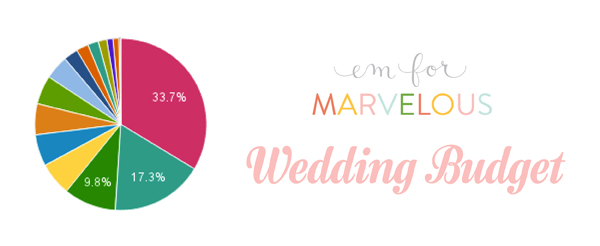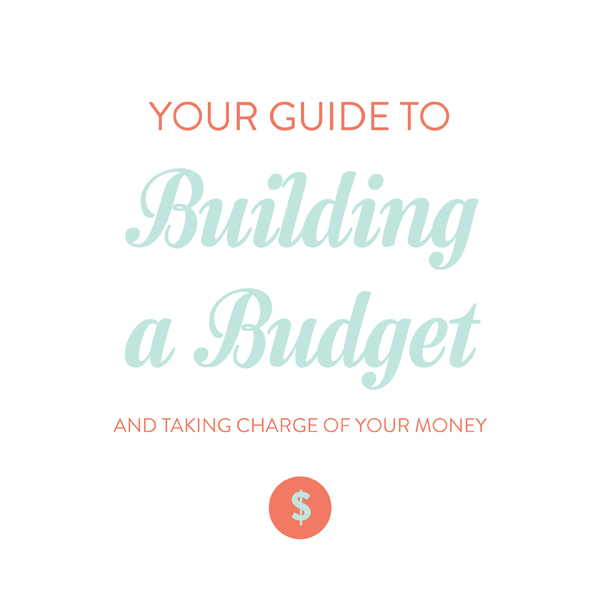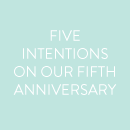4 March 2013
Happy Monday, friends! I’m here with the final post in our wedding series — at least for now :) I wanted to share our budget breakdown, in the hopes that it might be helpful for those of you currently planning.
A little background:
Date of wedding: September 15, 2012
Location: Southeastern Connecticut
Number of guests: 115
Contributors: My parents (43%), John’s parents (33%), John and me (13%), and my grandmother (11%)

I know that pie chart is tricky to see, so here’s the breakdown, from most to least:
33.7% ON CATERING | Includes food, staffing, bar, and tip.
17.4% ON RENTALS | Includes our 32×70′ Sperry tent with string and onion lighting, a catering tent, 15 high top tables, 11 8′ tables, 4 6′ tables, 9 36″ round tables, 2 bar back tables, 45 black chairs, a 16×16 black and white dance floor, four couches, 16 linens of various sizes from La Tavola, 16 basic linens from our local rental company, and a generator. The generator was a last-minute expense (like, the day before the wedding) that pushed this category way up.
9.8% ON PHOTOGRAPHY | Includes Tanja and Tia’s travel but does not include any sort of album.
6.3% ON CINEMATOGRAPHY | Includes a highlight and feature film; Inkspot did not charge us for travel as described here.
5.9% ON LOCATION | Our ceremony venue was free, so this includes use of the O’Neill’s Sea Porch and Sunken Garden.
5.8% ON FLOWERS | Includes 1 bridal bouquet, 4 bridesmaid bouquets, 2 small nosegays for our moms, 2 pin-on corsages for our grandmothers, 8 boutonnieres for the gents, 2 wreaths for the church doors, 21 small to medium centerpieces for the tent, 6 small centerpieces for cocktail hour high tops, and arrangements for the guest book, bar, and gift tablea.
5.4% ON BAND | Includes fee and tip.
4.5% ON GIRL ATTIRE | Includes my gown minus the amount we sold it for, alterations and cleaning post-wedding, my shoes, and half of my veil (I split it with my sister in law!).
2.7% ON HAIR & MAKEUP | Includes hair and makeup for the bride, as well as some subsidizing of hair for 5 others and makeup for 6 others.
2.3% ON STATIONERY | Includes 90 9×18″ custom-designed flat-printed invitations and envelopes, 90 response cards and envelopes, save the dates and envelopes, and postage for all of the above.
2% ON RECEPTION/COCKTAIL HOUR DECOR | Includes the four ottomans and four side tables we purchased from Ikea, all of the silver centerpiece vessels, our cubbies, candles, photo frames, etc.
1.6% ON THE CEREMONY | Includes bell and bow materials, our string trio, travel costs for our pastor, etc.
1.2% ON BOY ATTIRE | Includes John’s tux, tuxedo shirt, dress shoes, suspenders, cuff links, and tailoring.
1% ON DAY-OF COORDINATOR | This was a bit less than usual because Diana is a friend of ours.
.25% ON MISC. DIY PROJECTS | Includes various frames, signage materials, calligraphy ink, stickers for the poppers, etc.
.13% ON OTHER | I actually realized this entire category was made up of ribbon – ha!
Whew! I hope this was helpful! Note that this did not include our wedding bands, gifts, rehearsal dinner items, or our honeymoon or minimoon. I tried to include everything else but certainly could have missed a few things.

WHERE WE SAVED:
— I sold my gown post-wedding and recouped more than 50% of the cost. A designer gown would have been out of the question otherwise.
— I borrowed most of my accessories from friends and family or wore things I already owned. Marget and I also split our veil.
— Paying our bar on consumption versus a fixed price per person was a huge savings for us — over 50%.
— Our ceremony spot was so beautiful that we didn’t feel we needed any additional decor beyond the door wreaths.
— We splurged on custom designed invitations, but saved on flat printing versus engraved or letterpress.
— I made most of our signage with materials I already owned instead of paying someone else to do it. I also addressed our save the dates and invitations myself.
— We opted to drive my car instead of rent a vintage one for the day, and I restrained myself from purchasing custom cocktail napkins.
— We played a custom CD at cocktail hour instead of hiring musicians.
WHERE WE SPLURGED:
— A videographer. SO WORTH IT.
— Having a tapas style reception meant our staffing costs were much higher than they would have been over a buffet or sit-down style, but it was the bedrock of the “feel” we were going for.
— A Sperry tent versus a standard frame or pole tent.
— John’s dress shoes were about six times as expensive as mine (ha!) but because they’re dress shoes and not tuxedo shoes, he can wear them to work, church, etc. for years to come.
— We booked a luxe, large hotel room for Friday and Saturday night instead of staying at our nearby homes. The gals used it to get ready on Saturday morning and John and I stayed in it Saturday night.
Those are just a few examples for each category — I’m sure I could list many more.
One last thing I wanted to say: Weddings are my passion, and I’ve had a vision for my own for a long time. We have wonderfully generous parents that were happy to contribute to our special day, but early on I knew there were going to be costs going above and beyond the usual ones that I simply wouldn’t expect them to cover — namely top of the line photography and cinematography. We spent WAY more on capturing our day than most people would have, and it was important to me that John and I helped make up that cost. I started saving in college for our wedding, and I don’t regret it for a second. (Granted, not everyone knows who they’re going to marry at that point, but I did!) If you think you fall into the same category as me, start saving your pennies now! :)
I’d be happy to try and answer questions in the comments!
P.S. If you’d like to compare our percentages to the “average,” check out this link or this link.
read more
30 January 2013
I have followed a written budget for seven years now, and I can confidently say that it is the number one reason I feel at peace with my finances. I don’t worry about whether or not we’ll have enough money to pay our rent or car loans every month; I know we will. The headspace this surety frees up allows me to focus on my dreams and keeps me on track to reach my lifetime financial goals. There are few things better than that! I know you all are excited to talk budgeting, so let’s get cracking.
So what does it mean, exactly, to build a budget? Dave Ramsey likes to say that budgeting is “telling your money where to go.” I like that image. A budget helps me be purposeful about how I spend and save instead of just closing my eyes and hoping. While there are many ways to track a budget (some of which we’ll be covering in the next few weeks!), building a budget is pretty standard. It’s all about two things — income and expenses — which make up your cash flow.

1. Calculate your monthly net income (your gross income minus taxes). For most of us, this is simply our paycheck.
2. Add up all of your fixed expenses. Fixed expenses are difficult or impossible to change and are the same (or roughly the same) every month: rent, utilities, your electric bill, student loans, car loan(s), auto insurance, health insurance, etc.
3. Calculate your monthly contribution to your financial goals. Like the experts say, pay yourself first. Put money into an emergency fund, reduce debt with extra payments, save for a down payment, save for retirement, and/or feed an investment account. If it’s a priority for you, include charitable giving in this step. Some people choose to do this as a percentage of their income (i.e. 10% for tithing), while others choose a set amount. Whatever you do, do not skip this step! Treat your savings like any other budget line item, not as something optional if there’s money left over.
4. Add up all of your variable expenses. Like the name implies, these are things that are not externally set, so you could, for example, cut back here if you wanted to move faster toward your goals. Examples include groceries, dining out, clothing, entertainment, gifts, travel, gas, personal care, etc.
5. Put it all together. When you subtract your fixed expenses, your contributions to your financial goals, and your variable expenses from your net income, there are three possible outcomes: you’ll either have a surplus, you’ll break even, or you’ll have a deficit. If you come out with a surplus, you can either save more or spend more (assuming you’re already saving the recommended amounts!). If you break even, perfect! If you have a deficit, it’s time to take another look at your figures (most likely your variable expenses), and adjust numbers until you’re in the clear. No more money “accidents,” people! By the time your budget is finished, every dollar will have a destination!
Easy to understand, a bit harder to follow in practice! But we’ll get to that soon enough. Your homework for the week: walk through these steps, and start calculating! If you’ve never made a budget before and are unsure how much to allocate for certain categories, I’d suggest looking back through last month’s expenses (maybe on a credit or debit card statement) and estimating from there. It might take a few months to get the balance across categories just right.
Next week, I’ll show you how John and I track our budget, and the week after that, we’ll have a special guest post on another tracking option!
Happy budgeting! And be sure to leave questions or tips in the comments!!
read more
8 February 2012
Hello friends! Today I would like to talk with you about our videographer. Yes, we are having a videographer at our wedding!! (Two of them, actually!) I am so very excited about this, and I think I am especially excited because videography was something we always knew we wanted, but didn’t always know if it was something we could fit in our budget. I think that the budget realities of weddings are not something that gets discussed often enough, so today I would like to honestly walk you through our path to videography, in the hopes that it could be of help to one of you. Let’s go!
As I said, we knew from the very beginning that we wanted a videographer. We hired an insanely talented wedding photographer almost immediately (yay Tanja!) and know without a doubt that she will capture beautiful and priceless moments from our wedding day. However, because we went over our budget to hire Tanja (which I don’t regret!), we only were able to allocate $1,000 for videography in our initial budget. I knew full well that that was wayyyyy too low, but I chose to cross my fingers and hope that something would work out instead of doing something more productive.
Brad & Deena : wedding highlights from Inkspot Crow Films on Vimeo.
To complicate matters still further, John and I are unfortunately not a fan of any of the videographers we’ve found in Connecticut, Rhode Island, and Massachusetts. They’re just not our style, and most are so well established as to be prohibitively expensive, in my opinion.
No, our number one choice for videography was a little duo called Inkspot Crow. MacKenzie and Philip are based near us, in North Carolina, and I was initially introduced to them by my friend Meredith, who just so happens to be MacKenzie’s sister. We were immediately taken with their modern but classic filming style, and their story-driven editing. After working with them on a few projects through work, I also found them to be two of the nicest people around, and a great fit with my and John’s personalities. They are exactly the sort of people you want around on your wedding day.
Tim & Cate : wedding highlights from Inkspot Crow Films on Vimeo.
So I inquired! And as nice as MacKenzie is, even her niceness couldn’t help the fact that their basic package (for filming as well as a highlight and feature-length film) was three times our budgeted amount (you can do the math there). So we sadly parted ways, though MacKenzie did offer to waive their travel fee if we could make everything else work, since they could combine the trip up North with a visit to her Mom. A supremely kind offer to be sure, but still, not much to go on.
Fast forward to last month. I received a completely unexpected and very generous gift, and immediately decided to put it towards video. With that gift plus our initial budgeted amount, we were suddenly 2/3 of the way towards our goal. At that point, we knew we could make it work, so we sat down and took an even harder look at our budget. Extra hors d’oevres? Gone. Custom cocktail napkins? Gone. Less expensive (but still awesome!) band in favor of more expensive band? Yes. Mini cutting cake? Now being made by yours truly instead of our caterer (more about this to come!). With these cuts and more, we were able to shift enough of our resources towards video to make it a reality for us. Thankfully, Inkspot was still available for our date!
Alex & Katherine: wedding highlights from Inkspot Crow Films on Vimeo.
I know that videography isn’t a priority for everyone, and if it’s not for you, then that’s totally fine! But if it is a priority, and you haven’t hired someone because you don’t think you can afford it, I would encourage you to look again. I would make those cuts and more three times over to have a moving record of our day. We have a lifetime to throw parties with awesome details, but only one chance to capture the ones we love the most in action on one of the most special days of our lives. I have never heard a bride say she regrets spending money on videography, but I have heard more couples than I can count say not hiring a videographer is their number one regret. I didn’t want that to be us, and thankfully, it won’t be.
I will leave you with a completely adorable story, and though I might not be getting all of the details right, the sentiment is still true. A family with two little girls lives in the same apartment complex as John’s sister and her fiance. They went over to babysit one night, and the girls begged to watch “their favorite movie,” which they watch at least once a week with rapt attention. Yes, you guessed it: their favorite movie is their parents’ wedding video. I have a hard time thinking of a better reason to hire a videographer than that :)
P.S. Make sure you watch the highlight films from Inkspot interspersed throughout the posts! They’re some of my very favorites.
read more
22 April 2011
I love getting email from readers! Y’all are the best, and Kelly’s email was particularly awesome. She wrote:
“Hello Emily!
I’m an avid reader of Peach and Pearl way up north from Massachusetts. My junior prom is coming up in May, and I have a dress dilemma. I was inspired by your posts on the Rosecliff Ball, and “beauty on a budget.” I decided that I could do the same for my first prom. I have the dress already picked out. However, I have no clue what I should do for my makeup/accessories. I don’t have my ears pierced, so I guess earrings are out of the question. Have any ideas on how to complete the outfit?
Sincerely,
Kelly
First, I have to say that I’m tickled I have at least one reader that’s a junior in high school. Are there any more of you out there? Sound off in the comments! :)
Second, I loved prom, so I’m always happy to help. (John and I went together senior year! I will have to dig out some photos for you…)
Anyway, here’s Kelly’s dress:

It’s by Thread Social, though Kelly’s getting it through Rent the Runway — smart girl! I love the plum color.
I put together three different “looks”: one gold-toned, one silver-toned, and one more colorful. Happily, most of these accessories are interchangeable. And — bonus! — most pieces on here are less than $35, and many are less than $10. The general exception is the shoes… they were too pretty to resist, and all could be worn for years with proper care, so we’ll consider them an investment! The earrings are also all clip-ons, per Kelly’s request.

The Goods
A. Bracelet from Forever 21 ($8.80), heels from Nina ($89.95), clutch from Macy’s ($23.99), clip-on earrings from Macy’s ($32)
B. Clip-on earrings from Forever 21 ($5.80), bracelet set from Forever 21 ($4.80), shoes from Nordstrom ($79.95), clutch from Macy’s ($21.99)
C. Clutch from Macy’s ($34.99), shoes from Nina ($99.95, but I also loved these ruby-toned ones from Payless, and they were just $19.99!), clip-on earrings from Macy’s ($38), bracelet from Forever 21 ($5.80)
I also wanted to point out this pair and this pair of clip-on earrings I found in my search, though they didn’t make it into the final board.
On the topic of makeup I am certainly no expert, so I’ll just say that I love my Great Lash mascara and CoverGirl Lipslicks. Ladies, I’m sure our girl would appreciate any additional advice you could offer!
Kelly, I hope this has been helpful for you! And I hope you have a MARVELOUS time at the prom!!
read more
























